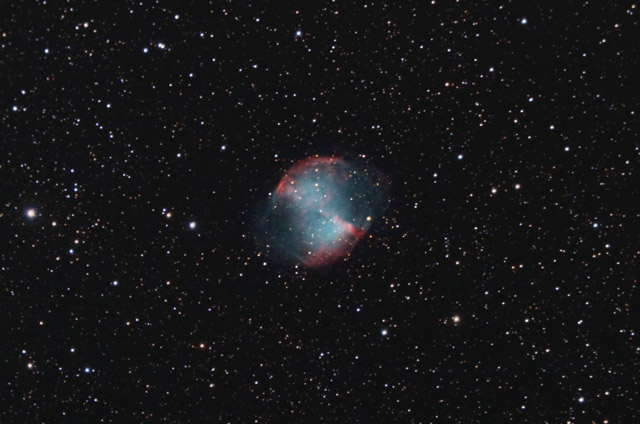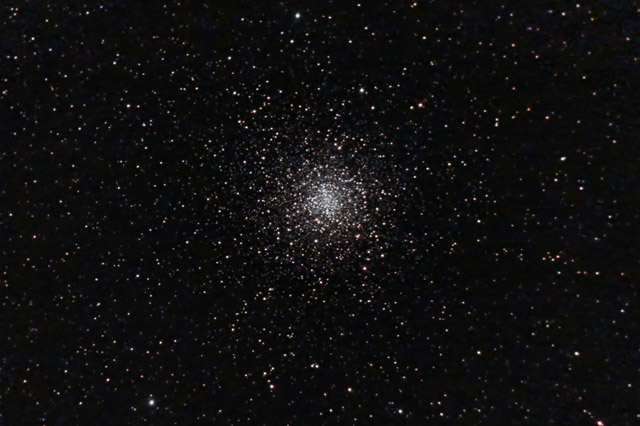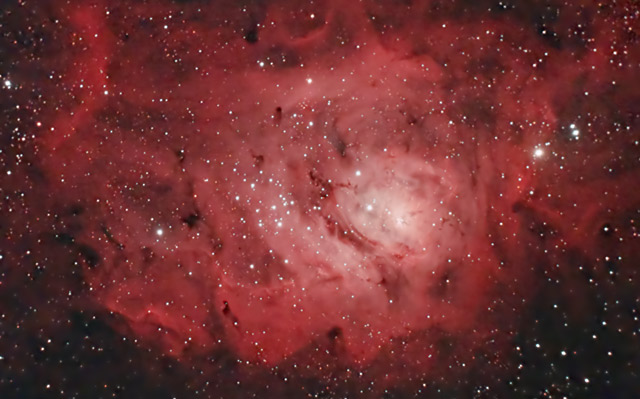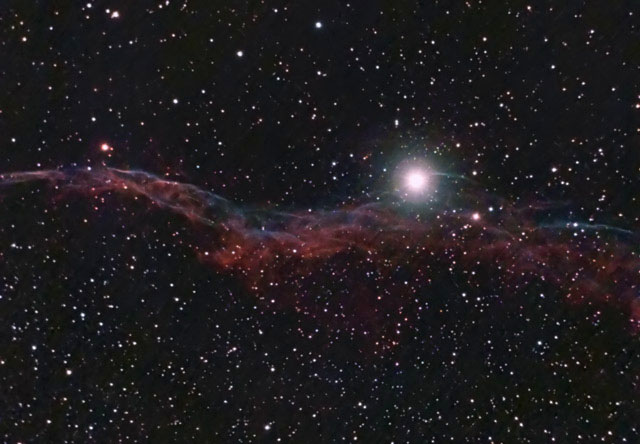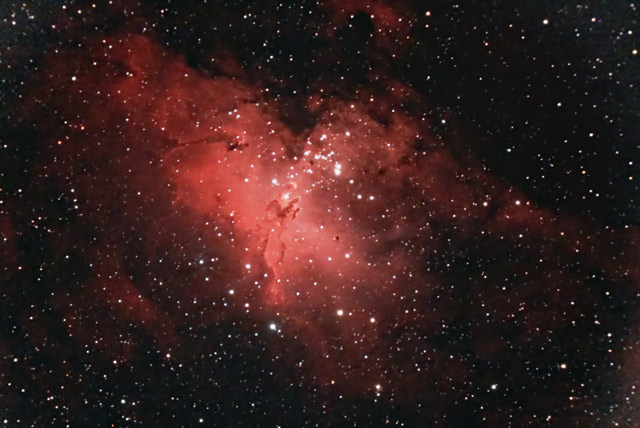______________________
The "Dumbbell" Nebula
On 7/15/06
|
The month of July is perhaps one of the worst times of the year for astrophotography in south Louisiana. Days are hot and so are the nights. Humidity is high and the mosquitoes are also in high-gear. Exhaust from thunderstorms usually fills the sky by sunset, and these high clouds take a long time to dissipate. Occasionally, a few nights in July are good, but it is rare. July 1st was such a night, but the results of that session were not up to par for posting here. I did show the guys on the astrophoto discussion groups on the internet, but it was mainly for tips on what not to do. lol However, by mid-month, another night clear enough to image presented itself. I was testing new equipment, and I managed to get an image of one of my favorite objects, the Dumbbell Nebula. I've shot it many times, but this image came out better than most, even though the equipment I tested basically failed to do what I thought it would. Live and learn, as they say! :-) |
|
M27, The "Dumbbell" Nebula on 7/15/06. Taken with a Celestron C-8 at F/5.8 (1160mm,) and a Baader MPCC. Guided with a Meade DSI and 100mm F/5 refractor. Camera is a Hutech Type 1 modified Canon 350 XT. Exposure was 26x90 second sub-images at 800 ISO. Processed and stacked in IRIS with dark, flat and bias calibration. Photoshop, RC-Astro's Gradient XTerminator and Noel Carboni's Astronomy Tools for post processing. Neat Image for noise reduction. Click here to see the full size hi-res version. |
______________________
M4 Globular Revisited
On 7/18/06
|
If one object could be called my "nemesis" object, it has to be the M4 Globular cluster. I've shot this object and failed to get an image out of the subs that I liked more times than any other object. This time, I used a Lumicon Deep Sky filter and that seemed to help with the quality. I was actually just testing focus and guiding for this one while waiting for another object (M8) to clear a tree so that I could shoot it. I wasn't trying to get a keeper image but I did. Go figure? lol |
|
M4 Globular Cluster on 7/18/06. Taken with a Celestron C-8 at F/5.8 (1160mm,) and a Lumicon Deep Sky filter. Guided with a Meade DSI and 100mm F/5 refractor. Camera is a Hutech Type 1 modified Canon 350 XT. Exposure was 22x150 second sub-images at 1600 ISO. Processed and stacked in IRIS with dark, flat and bias calibration. Photoshop, RC-Astro's Gradient XTerminator and Noel Carboni's Astronomy Tools for post processing. Neat Image for noise reduction. Click here to see the full size hi-res version. |
______________________
The "Lagoon" Nebula
On 7/18/06
|
Here is an image of one of the biggest and brightest of the southern summer Milky Way area nebulae. It is M8, the Lagoon Nebula. I have been trying to get a good image of it and this will suffice for the time being. |
|
The "Lagoon" Nebula, M8 on 7/18/06. Taken with a Celestron C-8 at F/5.8 (1160mm,) and a Lumicon Deep Sky filter. Guided with a Meade DSI and 100mm F/5 refractor. Camera is a Hutech Type 1 modified Canon 350 XT. Exposure was 9x150 second sub-images at 1600 ISO and 39x90 sec sub-images at 800 ISO. Processed and stacked in IRIS with dark, flat and bias calibration. Photoshop, RC-Astro's Gradient XTerminator and Noel Carboni's Astronomy Tools for post processing. Neat Image for noise reduction. Click here to see the full size hi-res version. |
______________________
The Veil Nebula
Supernova Remnant
On 7/22/06
|
A very long time ago, a star exploded as a supernova in the constellation Cygnus and left behind a remnant. It is very dim and needs a long exposure to display it properly. I managed to get a half-decent image of part of it by combining 40 sub-images of a relatively short exposure length of 90 seconds each. I could increase this to 300 seconds each easily, since there is quite a bit of dim material there that is only evident at the longest exposure times. |
|
The "Veil" Nebula Supernova Remnant on 7/22/06. Taken with a Celestron C-8 at F/5.8 (1160mm,) and a Lumicon Deep Sky filter. Guided with a Meade DSI and 100mm F/5 refractor. Camera is a Hutech Type 1 modified Canon 350 XT. Exposure was 40x90 second sub-images at 800 ISO. Processed and stacked in IRIS with dark, flat and bias calibration. Photoshop, RC-Astro's Gradient XTerminator and Noel Carboni's Astronomy Tools for post processing. Neat Image for noise reduction. Click here to see the full size hi-res version. |
______________________
The Eagle Nebula
On 7/30/06
|
One of my favorite nebulae is the Eagle. The Eagle Nebula was made famous by the Hubble Space Telescope when the "Pillars of Creation" picture was released. This is the central region of dust in my image below. |
|
The Eagle Nebula on 7/30/06. Taken with a Celestron C-8 at F/5.8 (1160mm,) and a Lumicon Deep Sky filter. Guided with a Meade DSI and 100mm F/5 refractor. Camera is a Hutech Type 1 modified Canon 350 XT. Exposure was 20x150 second sub-images at 1600 ISO. Processed and stacked in IRIS with dark, flat and bias calibration. Photoshop, RC-Astro's Gradient XTerminator and Noel Carboni's Astronomy Tools for post processing. Neat Image for noise reduction. Click here to see the full size hi-res version. |
All Images Copyright © 2006 Mike Broussard.
All rights reserved.
To send comments or for more information, please email me at
mike@synergyitg.com.
Visitors since July 25, 2006
